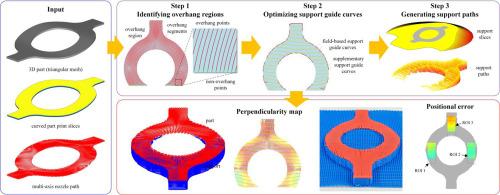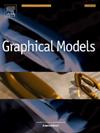Sparse support path generation for multi-axis curved layer fused filament fabrication
IF 2.2
4区 计算机科学
Q2 COMPUTER SCIENCE, SOFTWARE ENGINEERING
引用次数: 0
Abstract
In recent years, multi-axis fused filament fabrication has emerged as a solution to address the limitations of the conventional 2.5D printing process. By using a curved layering strategy and varying the print direction, the final parts can be printed with reduced support structures, enhanced surface quality, and improved mechanical properties. However, support structures in the multi-axis scheme are still needed sometimes when the support-free requirement conflicts with other constraints. Currently, most support generation algorithms are for the conventional 2.5D printing, which are not applicable to multi-axis printing. To address this issue, we propose a sparse and curved support filling pattern for multi-axis printing, aiming at enhancing the material efficiency by fully utilizing the bridge technique. Firstly, the overhang regions are detected by identifying the overhang points given a multi-axis nozzle path. Then, an optimization framework for the support guide curve is proposed to minimize its total length while ensuring that overhang filaments can be stably supported. Lastly, the support layer slices and support segments that satisfy the self-supported criterion are generated for the final support printing paths. Simulation and experiments have been performed to validate the proposed methodology.

多轴弯曲层熔丝制造的稀疏支撑路径生成
近年来,多轴熔丝制造已经成为解决传统2.5D打印工艺局限性的一种解决方案。通过使用弯曲的分层策略和改变打印方向,最终零件可以打印出更少的支撑结构,增强表面质量,改善机械性能。然而,当无支撑要求与其他约束条件发生冲突时,仍需要在多轴方案中使用支撑结构。目前,大多数支撑生成算法都是针对传统的2.5D打印,并不适用于多轴打印。为了解决这一问题,我们提出了一种稀疏弯曲的多轴打印支撑填充图案,旨在充分利用桥接技术提高材料效率。首先,在给定多轴喷管路径的情况下,通过识别喷管的悬垂点来检测喷管的悬垂区域;然后,在保证悬垂细丝稳定支撑的前提下,提出了支撑导向曲线的优化框架,使其总长度最小。最后,生成满足自支撑条件的支撑层切片和支撑段,形成最终的支撑打印路径。仿真和实验验证了所提出的方法。
本文章由计算机程序翻译,如有差异,请以英文原文为准。
求助全文
约1分钟内获得全文
求助全文
来源期刊

Graphical Models
工程技术-计算机:软件工程
CiteScore
3.60
自引率
5.90%
发文量
15
审稿时长
47 days
期刊介绍:
Graphical Models is recognized internationally as a highly rated, top tier journal and is focused on the creation, geometric processing, animation, and visualization of graphical models and on their applications in engineering, science, culture, and entertainment. GMOD provides its readers with thoroughly reviewed and carefully selected papers that disseminate exciting innovations, that teach rigorous theoretical foundations, that propose robust and efficient solutions, or that describe ambitious systems or applications in a variety of topics.
We invite papers in five categories: research (contributions of novel theoretical or practical approaches or solutions), survey (opinionated views of the state-of-the-art and challenges in a specific topic), system (the architecture and implementation details of an innovative architecture for a complete system that supports model/animation design, acquisition, analysis, visualization?), application (description of a novel application of know techniques and evaluation of its impact), or lecture (an elegant and inspiring perspective on previously published results that clarifies them and teaches them in a new way).
GMOD offers its authors an accelerated review, feedback from experts in the field, immediate online publication of accepted papers, no restriction on color and length (when justified by the content) in the online version, and a broad promotion of published papers. A prestigious group of editors selected from among the premier international researchers in their fields oversees the review process.
 求助内容:
求助内容: 应助结果提醒方式:
应助结果提醒方式:


